#Centrolenidae
Text
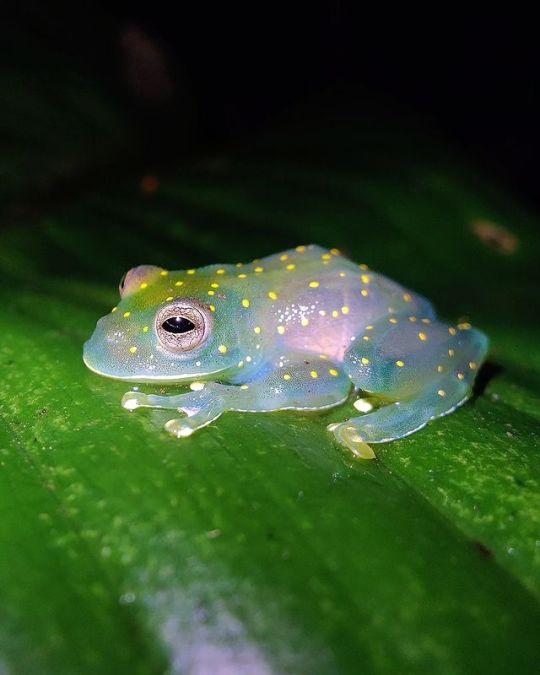


San Jose Cochran Frog
1K notes
·
View notes
Note
Which frog is well-dressed but well-armed as well?
Personally I have huge respect for someone who commits to a suit that is all one colour, and centrolenid frogs (glass frogs) commit pretty hard to that style, though with occasional polka-dots for good measure. But don't let their high fashion fool you. They are very well armed—at least for battles with each other. Many glass frogs possess fearsome humeral spines; sharp extensions of the upper arm.

[src]
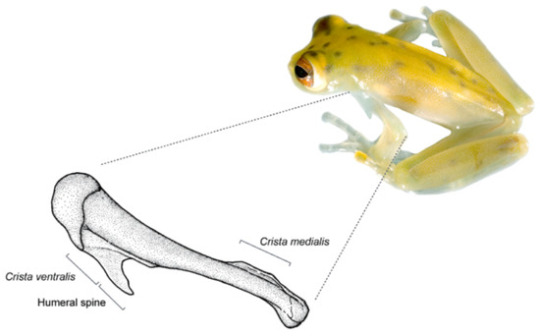
[src]
So they're pretty literally well-armed.
#frog#science#herpetology#animals#frogs#anura#amphibia#Centrolenidae#Centrolene#I could also have given all kinds of poison frog answers#or other groups with crazy adaptations#but the well-armed pun was too tempting#answers by Mark#reverth9
2K notes
·
View notes
Text
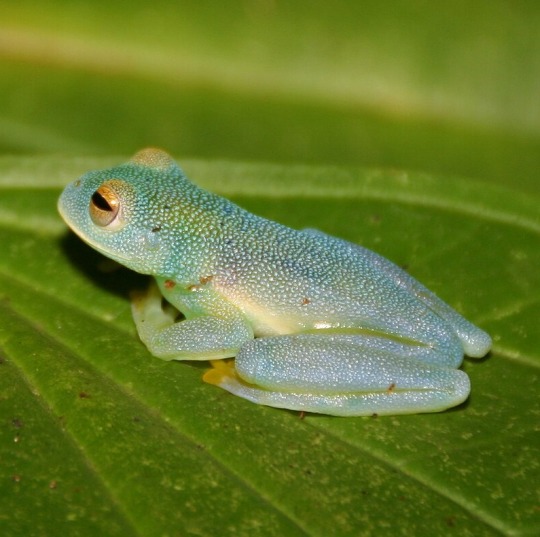
Granular Glass Frog (Cochranella granulosa), family Centrolenidae, Manuel Antonio NP, Costa Rica
photograph by JurriaanH
1K notes
·
View notes
Text
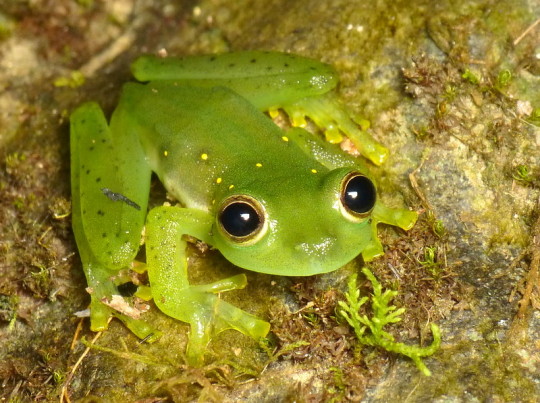
An emerald glassfrog (Espadarana prosoblepon) in Imbabura, Ecuador
by Andreas Kay
#emerald glassfrog#glass frogs#frogs#amphibians#espadarana prosoblepon#espadarana#Centrolenidae#anura#amphibia#chordata#wildlife: ecuador#wildlife: south america
868 notes
·
View notes
Text
Uncharismatic Fact of the Day
Camouflage is a valuable skill in the animal kingdom, and what better way to do it than to make yourself see-through? Glass frogs accomplish this by storing most of their blood in their livers while they sleep, rendering them almost completely transparent! When awake, they appear mostly green, except for their undersides which remain partially translucent.

(Image: A northern glass frog (Hyalinobatrachium fleischmanni) both sleeping and awake by Jesse Delia)
If you like what I do, consider leaving a tip or buying me a ko-fi!
648 notes
·
View notes
Text
Glass Frogs
(you can see their organs, so I'm putting the rest under the cut)
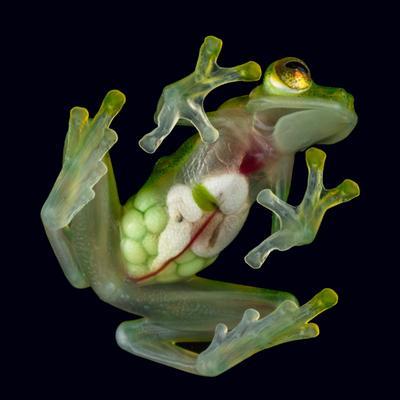
AKA the Centrolenidae family
Wowzers!! You can see their organs!!
Glass frogs are a family of over 60 species, with varying levels of see-through-ness to their skin!! In some, you can even see their heart beating!!
They hail from Central or South America, and mostly live in trees. Apparently being transparent makes them a bit harder to make out on the leaves, like a funky new sort of camouflage!
0 notes
Link
Quito, 9 may (EFEverde).- Dos nuevas especies de "ranas de cristal" (Centrolenidae), denominadas así por la transparencia de su piel que permite ver parcial o totalmente sus vísceras o huesos, fueron descubiertas en los Andes de Ecuador, según anunció este martes en un comunicado el Instituto Nacional de Biodiversidad (Inabio).
0 notes
Text
Sachatamia ilex | Massimo
Sachatamia ilex | Massimo
Sachatamia ilex is a species of frog in the family Centrolenidae and it is found in Central America. Its silver eyes with black reticulations, positioned on top of the large semicircular head may give you the impression this frog is going to hypnotize you https://t.co/UBn1bSkIQU pic.twitter.com/NWolbiC3Mv
— Massimo (@Rainmaker1973) August 17, 2022
View On WordPress
0 notes
Photo

The glass frogs are frogs of the amphibian family Centrolenidae (order Anura) via r/oddlysatisfying
0 notes
Text
What Do Tree Frogs Eat
New Post has been published on https://www.petculiars.com/what-do-tree-frogs-eat/
What Do Tree Frogs Eat
Tree frogs will usually be seen on tall vegetation, especially on trees. This is where their name comes from. This article will give you a few pointers on the tree frog diet.
The colorful appearance and considerably small size, make tree frogs very popular exotic pets. There isn’t just one tree frog type but a bunch, belonging to families like Hyperoliidae, Centrolenidae, Hylidae, and Rhacophoridae. Even a few genera, like Pedostibes of the Bufonidae family or the Boophis of the Mantellidae family, will have a few tree frogs among them. Even so, the ones considered the true tree frogs are frogs from the Hylidae family, although this particular family also has semi-aquatic or terrestrial species. Most, if not all of the tree frogs, will be found on tall shrubs and trees near of still-water bodies, regardless of their actual genera or family.
Tree frogs can have a lot of different color ranges, from gray, brown, or green, to a mix of brighter colors. You should also know that most bright-colored tree frogs are considered highly toxic. As a camouflage defensive system, some frogs will also have the ability to change the color of their body. Some might even have different patterns and designs on their body like spots and lines.
You might also like my articles on the diet of normal frogs and cute names for frogs.
They usually have a body length that could range from 1 to 6 inches. Their weight will also be anywhere between 2 and 17 grams. These frogs will have a lifespan between 2 and 4 years, and sometimes more. The tree frog has long legs, perfect for climbing and jumping, as an adaptive measure for arboreal life. To cling to leaves, branches, or stems, these creatures also have adhesive toe pads. They have almost binocular vision due to their protruding, round, and big eyes. To catch their prey, tree frogs will use their very sticky tongues, just like most other frogs.
The Diet of Tree Frogs
Although some tree frogs are seen hunting during the daytime, this only happens if they’re hungry enough, as these creatures are mostly nocturnal. Usually, tree frogs are carnivorous by nature, although their general diet will differ slightly depending on their species and geographical location. Their usual diet will be made from a combination of small invertebrates, worms, and insects. Experts have also noticed that there are species, especially on the larger side, that will eat small fish, other frogs, and even small mammals. One of the most popular tree frogs is the Cuban frog, which can be found in North America and is the largest known tree frog. These frogs are known to be great climbers, which enables them to hunt and feed on a lot of creatures, like bird hatchlings, crustaceans, other frogs, lizards, snakes, spiders, snails, and insects.
Food for Pet Tree Frogs
These frogs can usually be kept as pets, as most of them are docile in nature and very attractive in appearance. This is why a lot of people will want to own one of these exotic creatures as a pet. Out of all the tree frogs, the most popular breeds are the red-eyed frog, the Australian green tree frog, and the American green tree frog. It might seem easy to attend for a tree frog at first, but before getting one, you should have extensive knowledge of these creatures and the proper way in which you can care for them. Depending on their actual species and sizes, these requirements can differ.
When it comes to actually feeding your pet tree frog, you should always have a supply of live mealworms, flies, and live crickets on hand. Keep in mind that you will have to understand your particular breed and attend to its individual requirements and needs. For example, the Pacific tree frog will eat mostly ants, flies, beetles, and spiders, while the green tree frogs will like worms and crickets more. Most of the time, you will feed your tree frog with worms and insects, especially the gut-loaded ones. You should always try to get prey of appropriate size based on the size of your frog.
If you have a juvenile frog, then you can use cockroaches, moths, and flies as part of its daily diet. You will have to feed an adult frog around two to three times per week. You can also give them two to five small crickets every other day. Before giving it to your frog, try to dust the insect with multivitamin powder and calcium. You will also have to mist your frog with water that has no chlorine, each day, preferably in the morning. You should also have a separate enclosure to use for feeding. When it comes to the pet tree frog, you can get live crickets or other types of food from the pet store. Tadpoles won’t be carnivores at first and will require pond plants and algae for a healthy diet. You can also feed them boiled lettuce leaves until they grow and turn to a carnivorous diet.
As you might already know, frogs will stick their tongues out to hunt their prey. THey will eat any insects that get stuck on their tongues, including flies or moths. Although they will usually just stay put and wait for the prey to land on their tongues, they might jump or leap in an effort to catch prey. Frogs don’t have teeth good enough to chew or even cut their food, so they will swallow it whole. Tree frogs will like to hunt live insects even when kept as pets, although babies will still have to be fed. Although you will have to feed them consistently and regularly, you should try to avoid overfeeding them.
0 notes
Photo

Nymphargus cochranae by jorgebrito
#Anura#Centrolenidae#Nymphargus#Nymphargus cochranae#frog#frogs#animal#animals#biology#nature#wildlife#amphibian#amphibians#zoology#herpetology#herps#fauna#critter#critters
800 notes
·
View notes
Text
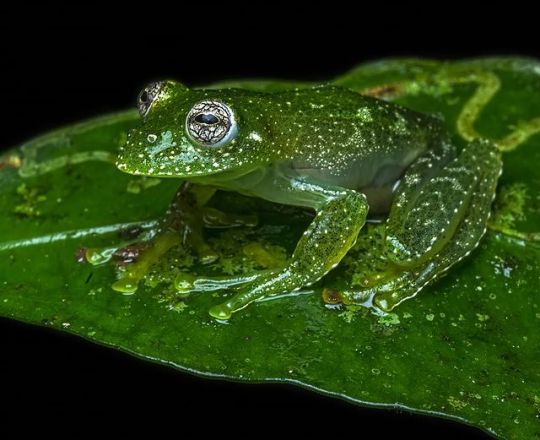
Vitreorana uranoscopa
26 notes
·
View notes
Text

Cochranella
#cochranella#centrolenidae#wikipedia#wikipedia pictures#frogs#frog#glass frog#animals#amphibia#amphibians
294 notes
·
View notes
Text
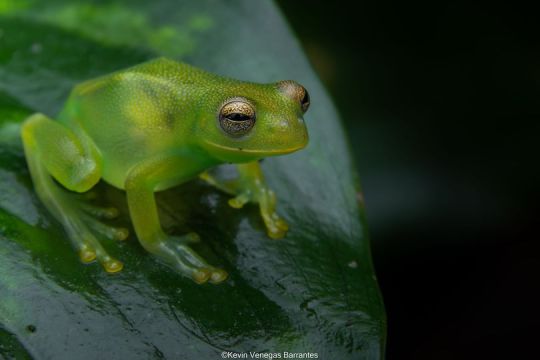
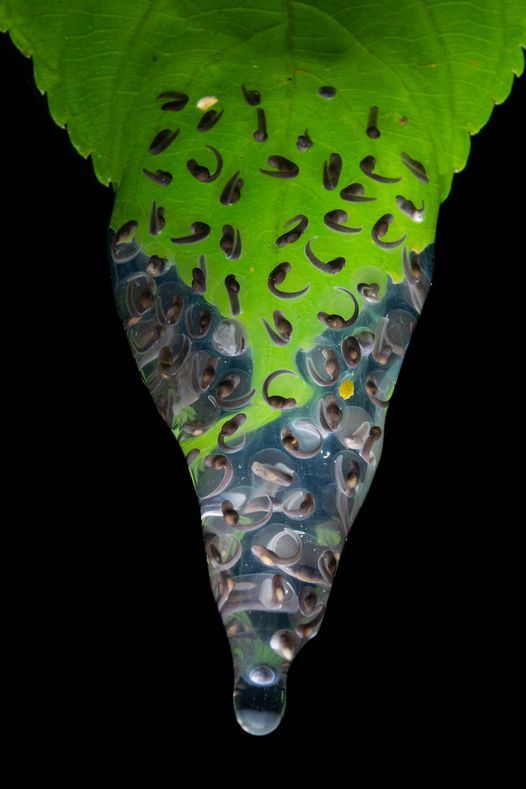
Granular Glass Frog (Cochranella granulosa), adult and eggs attached to leaf overhanging water, family Centrolenidae, Costa Rica
photograph by Kevin Venegas
666 notes
·
View notes
Photo
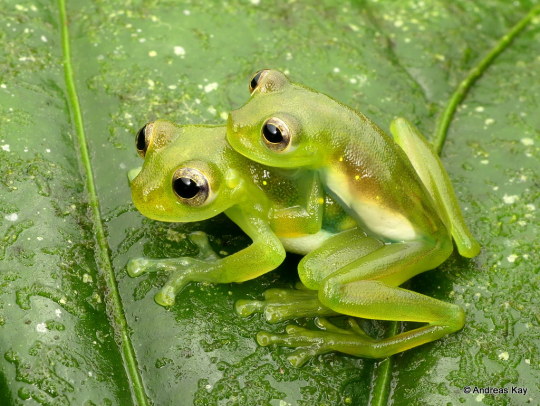
Santa Cecilia Cochran frogs (Teratohyla midas) in amplexus i.e., mating at the Tamandua Ecolodge and Reserve in Ecuador
Andreas Kay
414 notes
·
View notes
Photo

“The Lazarus effect” is something nice you read about but when you actually witness it with your own eyes it’s a totally different thing. This glass frog, a male Cuzco Cochran frog (Rulyrana spiculata) was believed extinct from the Kosnipata Valley since 10 years (and only believed still present in a single valley more on the North). So when Alessandro Catenazzi (@acatenazzi ) and I found this calling male along a small stream of the cloud forest, our happiness completely washed out every bit of fatigue and drowsiness from us. We felt alive and hopeful. Because we still have a chance to reduce our impact and to save at least some of the threatened species around the world. Some of them, can “come back” from oblivion if we give them enough space and time. #amphibian #glassfrog #rulyrana #centrolenidae #peru #amazon #cusco #andes #cloudforest #picoftheday #herp #herping @conservacionamazonica @ilcp_photographers https://www.instagram.com/p/CF9DR7ZAWBr/?igshid=1acpoxin5iynu
#amphibian#glassfrog#rulyrana#centrolenidae#peru#amazon#cusco#andes#cloudforest#picoftheday#herp#herping
200 notes
·
View notes